The term “meditation” means different things to different people. Depending on the intent and focus of the meditative practice, a wide variety of goals can be pursued. Some practitioners meditate simply to reduce tension and stress. Others meditate to increase their level of awareness or to improve their ability to concentrate. Still others meditate to achieve spiritual development and enlightenment. The type of meditation that is practiced is dependent on the specific objectives the practitioner is trying to accomplish.
As with all methods that are taught in the Ba Gua Zhang of Lu Shui-Tian, every student must start with the basics. The first method that the student learns, the Basic Meditation Exercise, is very simple and direct. This method is designed to help the student learn how to relax the body, calm the mind, and improve mental concentration and focus. The student learns how to stay focused on one thing to the exclusion of all else. This not only calms the mind and increases the ability to concentrate, it also aids in the body’s natural ability to rejuvenate itself. For when the mind is calm and focused, the body can use its innate natural power to heal itself and replenish its internal energy or Qi.
The Basic Meditation Exercise of the Ba Gua Zhang Method of Lu Shui-Tian:
The “Reverse Count” Meditation
- Begin by assuming a comfortable seated position.
- Keep the breathing relaxed and follow a natural breathing rhythm.
- Close the eyes and calm the mind.
- Initially, while maintaining a natural breathing rhythm, a relaxed body, and a calm mind, begin counting backwards slowly from a Starting Value of 300.
- Visualize each number clearly in the mind’s eye and “speak” the number either silently or aloud. Exactly what form the number will take when visualized will vary from person to person. It is best to keep it plain and simple.
- While performing the reverse count, the mind will inevitably wander off on other thoughts and you may lose track of the number sequence. Each time this happens, return to the last number visualized and resume the count.
- The goal is to complete the reverse count without any breaks or loss in focus.
The student should practice this meditation exercise in a quiet, comfortable place that is free from distraction. Any external distraction can easily cause the mind to wander and lose focus. A quiet, comfortable environment facilitates higher levels of concentration, increased levels of relaxation, and deeper levels of meditation.
During the last several years of his life, my teacher Lu Shui-Tian spent much of his time in meditative practice. Everyone, including myself, was forbidden from entering his room when he was meditating. On one occasion, I forgot and opened the door to his room. As the door swung open, I was hit in the head with a book that Master Lu had flung across the room – after which he said, “I told you not to enter my room when I was meditating.” Meditation practice is generally best carried out in private.
In the Ba Gua Method of Lu Shui-Tian, the teacher will often check a student’s progress by having him or her perform the Reverse Count Meditation while counting out loud. Once the student has demonstrated the ability to concentrate sufficiently, the Starting Value will be increased from 300. Eventually, students will move on to other concentration and visualization methods which will help them to maintain mental calmness and focus for longer and longer periods of time.
At this basic stage, the Meditative Practice is not linked to any Breathing Practice or Qi Circulation Practice. No attempt is made to move the Qi with the mind or to visualize the circulation of Qi in the body. It is important to remember that in the Ba Gua Method of Lu Shui-Tian, every aspect of Qi Gong (Chi Kung) Training is practiced independently, in isolation, until the student can demonstrate a certain minimum level of development.
While there are many techniques that involve the use of mental visualization to aid the flow of Qi along the meridian pathways or to certain points of the body, these practices are inappropriate and even dangerous for the beginning or inexperienced student. Visualization techniques are appropriate only after a certain stage of the training has been reached.
First, the beginner to meditition has not developed the necessary ability to focus his or her attention for a long enough period of time to make the visualization techniques effective. In the Method of Lu Shui-Tian, no practitioner is ready for the use of Visualization Methods to assist in Qi circulation until he or she can maintain meditative focus while counting backwards slowly from a specified Starting Value** to 0 without interruption. [**EDITOR’S NOTE: The minimum standard for the Starting Value of the Reverse Count Meditation that practitioners must meet as specified by Lu Shui-Tian will not be presented here because it is deemed inappropriate for this type of general introductory article.] If the student loses count or becomes distracted from the steady, deliberate countdown, then, no Qi Movement Visualization Techniques will work properly.
Second, if practitioners have already developed some ability to move the Qi in the body, along the “microcosmic orbit” or along any of the other pathways used in popular Qi Gong practice, but cannot maintain complete focus and concentration on what they are doing, they are in danger of causing an overabundance of Qi to become trapped in the head. Qi will rise to the head if the mind becomes distracted while using visualization methods once a sufficient amount of energy begins flowing in the body. This condition is called Shang Qi (Rising Qi) and can be dangerous. Shang Qi can result in severe headaches, a feeling of intense pressure in the head, or migraines. It is not a pleasant experience and can take weeks to go away. In severe cases, treatment may be required.
Students that are very new to Qi Gong Practice may not be in great danger of developing a Shang Qi condition because they have not yet built up sufficient internal energy in the body. However, once the student has begun practicing the powerful Breathing Exercises and Qi Circulation Exercises of Ba Gua, the Qi may become sufficiently strong, after only a few months practice, that it can lead to problems if the Meditation is introduced incorrectly.
For these and other reasons, Meditative Practice is kept separate from Qi Circulation Practice and Breathing Practice in the Ba Gua Method of Lu Shui-Tian. Each of these three areas must be developed independently. When the student has developed a certain minmum level of ability in all three of these areas, he or she may then proceed to combine these methods. Only an experienced teacher can know when a student is ready to move on to the more advanced Qi Circulation, Breathing, and Visualization Methods.
The Footwork, Palmwork, and Bodywork Training exercises of the Ba Gua Zhang of Lu Shui-Tian are very physically demanding. If the Ba Gua practitioner does not balance these rigorous External Exercises with proper Internal Practice consisting of the proper Breathing Exercises, the proper Qi Circulation Exercises, and the proper Meditation Exercises, the body will begin to break down. Without a training program that is naturally balanced, the student will start to struggle and will be unable to continue following the physical training regimen that is required.
Exercises that are designed to help rejuvenate the body and replenish expended energy, such as the Qi Gong Exercises being discussed here, are equally as important as exercises designed to increase fighting skill.
As with all such methods of Internal Practice, none of these exercises should be attempted without the close supervision of a qualified and experienced instructor.
Note: [For more information about Ba Gua Qi Gong training refer to these entries:
[ Above is an edited excerpt from “The Fundamentals of Pa Kua Chang: The Method of Lu Shui-T’ien as Taught by Park Bok-Nam,” by Park Bok-Nam and Dan Miller, published by High View Publications in 1993. This book, along with its companion video and follow-on volume, are currently available here and from all prominent martial arts bookstores and mail order catalogs. ]

